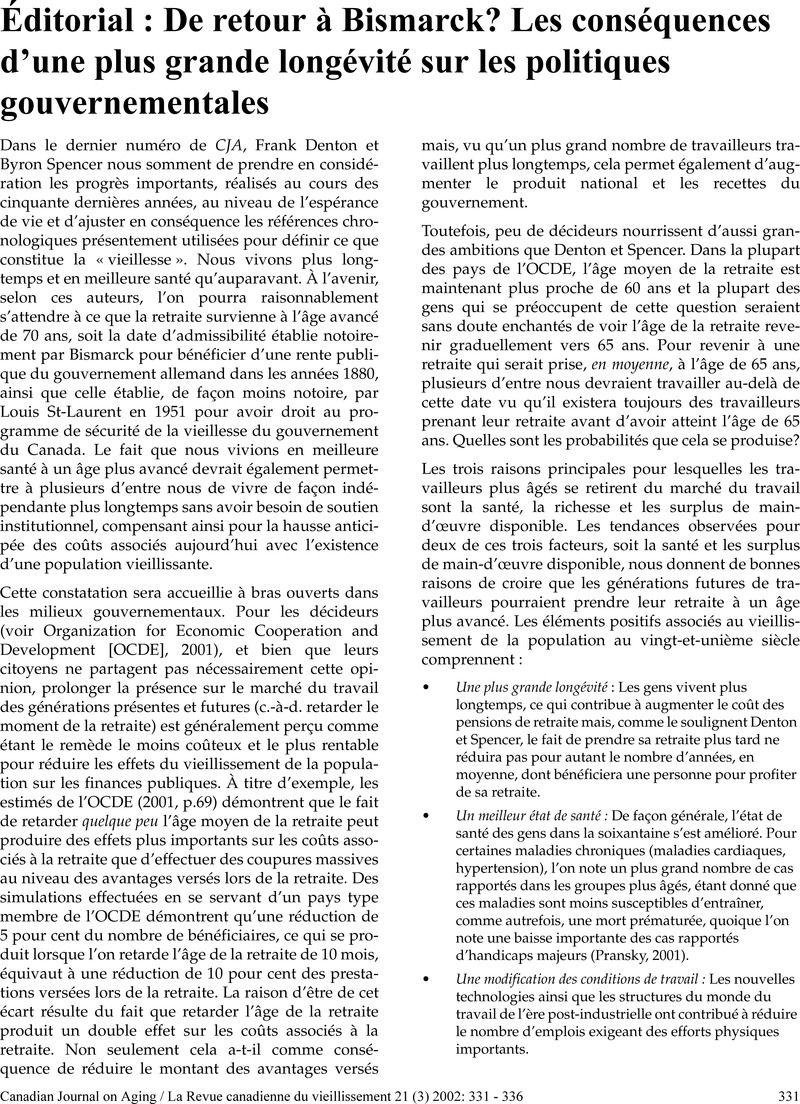No CrossRef data available.
Article contents
Éditorial: De retour à Bismarck? Les conséquences d'une plus grande longévité sur les politiques gouvernementales
Published online by Cambridge University Press: 31 March 2010
Abstract
An abstract is not available for this content so a preview has been provided. As you have access to this content, a full PDF is available via the ‘Save PDF’ action button.

- Type
- Editorial/Éditorial
- Information
- Canadian Journal on Aging / La Revue canadienne du vieillissement , Volume 21 , Issue 3 , Fall/Automne 2002 , pp. 331 - 336
- Copyright
- Copyright © Canadian Association on Gerontology 2002
References
Barr, N. (2001). The welfare state as piggy bank: Information, risk, uncertainty and the role of the state. Oxford: Oxford University Press.CrossRefGoogle Scholar
Burtless, G., & Quinn, J. (2001). Retirement trends and policies to encourage work among older Americans. In Budetti, P., Burkhauser, R., Gregory, J., & Hunt, H. A. (Eds.), Ensuring health and income security for an aging workforce (pp. 375–416). Kalamazoo Kalamazoo, MI: Upjohn Institute.CrossRefGoogle Scholar
Diamond, P., & Hausman, J. (1984). Individual retirement and savings behavior. Journal of Public Economics, 23, 81–114.CrossRefGoogle Scholar
Haber, C., & Gratton, B. (1994). Old age and the search for security: An American social history. Bloomington: Indiana University Press.Google Scholar
Heisz, A., Jackson, A., & Picot, G. (2001). Distributional outcomes in Canada. In Banting, K., Sharpe, A., & St-Hilaire, F., (Eds.). The longest decade: Canada in the 1990s (pp. 247–272). Montreal: Institute for Research on Public Policy.Google Scholar
Hicks, P. (2001). Public support for retirement income reform. Paris: Organization for Economic Cooperation and Development. Trouvé le 13 août, 2002, sur le Site Web de L'OCDE http://www.oecd.orgCrossRefGoogle Scholar
Morissette, R., Zhang, X., & Drolet, M. (2002). The evolution of wealth inequality in Canada, 1984–1999 (Analytical Studies Branch, Research Paper No. 187). Ottawa: Statistics Canada.Google Scholar
Myles, J. (2000). The maturation of Canada's retirement income system: Income levels, income inequality and low income among older persons. Canadian Journal on Aging, 19, 287–316.CrossRefGoogle Scholar
Myles, J. (in press). A new social contract for the elderly? In Esping-Andersen, G., Gallie, D., Hemerijck, A., & Myles, J. (Eds.). Why we need a new welfare state. Oxford: Oxford University Press.Google Scholar
Myles, J., & Pierson, P. (2001). The comparative political economy of pension reform. In Pierson, P. (Ed.). the new politics of the welfare state (pp. 305–333). Oxford: Oxford University Press.CrossRefGoogle Scholar
Organization for Economic Cooperation and Development (1996). Caring for frail elderly people. Paris: Author.Google Scholar
Organization for Economic Cooperation and Development (2001). Aging and income: Financial resources and retirement in 9 OECD countries. Paris: Author.Google Scholar
Pransky, G. (2001). Living longer but able to work? In Budetti, P., Burkhauser, R., Gregory, J., & Hunt, H. A. (Eds.). Ensuring health and income support for an aging workforce (pp. 431–438). Kalamazoo, MI: Upjohn Institute.Google Scholar
Scherer, P. (2002). Age of withdrawal from the labour force in OECD countries. Paris: Organization for Economic Cooperation and Development. Trouvé le 13 août, 2002, sur le Site Web de L'OCDE http://www.oecd.orgGoogle Scholar
Thompson, L. (1998). Older and wiser: The economics of public pensions. Washington: The Urban Institute.Google Scholar
Wolf, D. (1999). The family as provider of long-term care: efficiency, equity and externalities. Journal of Aging and Health, 11, 360–382.CrossRefGoogle ScholarPubMed


